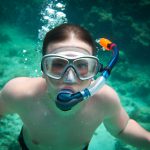Snorkelling is a tool used to access one of nature’s most marvellous realms, and the ocean remains one of the best arenas for exercising our sense of discovery, as well as our bodies. The key to successful snorkelling is relaxation in the water. Try not to overanalyze. Practice will improve your skills and comfort in the water. The tips below assume you already have well fitting equipment. If not:
A. Be sure the mask fits your face. Hold the snorkel mask up to your face clearing the strap from your face. Breath in through your nose. The mask should seal perfectly and stay on, without holding it, for as long as you breath in. If any air leaks in, water will also. Keep all hair out of the seal, if you have a moustache, use a good glob of vaseline, sunscreen or chap stick below your nose to act as a “gasket,” or consider shaving the area right below the nose.
The strap should only fit snugly at the widest part of your head, towards the top of the back of your head. If it’s at the base of your skull, water may seep in. If water does start seeping in while snorkelling, reach back and see if your strap has slipped down. Don’t tighten the strap beyond “snug,” being too tight causes leaking, as the seal can be broken. The pressure of the water will help seal the mask to your face. The snorkel should rest in front of your ear.
B. Choose fins that are comfortable but not too tight. If they hurt or curl your toes especially, you may develop cramps while snorkelling. If they slip off your heels, they’re too big. Better a little big than too small. Remember they will slip on easier when your feet are wet.
- Defog. No point going through all the trouble if you can’t see anything. Products made for defogging seem to work OK but saliva is the best and we carry it always.
- Practice breathing through the snorkel with your head out of the water before the real thing. Put the mask on your head (wear your strap slightly high on the back of your head and not too tight!), suck it into your face, breathe through the tube (put the mouthpiece all the way in your mouth, like a football players mouthpiece and close your lips around it). Don’t bite, just rest your teeth on the bite thingies – or your jaw will get really sore.
When ready, practice calm floating in the face down and horizontal position. Having something (scenery, rocks, fish, or even your finger tips waving) to focus on helps by distracting you from overanalyzing (worse as we get older).
- Masks should remain reasonably dry on the inside, but they can accidentally fill with water. This usually happens when the strap has slipped down to far. A flooded mask can be easily cleared by raising the head, pulling the lower edge away from the mouth, and simply letting the water drain out. I like to leave a little water in my mask, where it can be swished around for an instant defog.
The same applies to snorkels. A burst of air (similar to a dolphin blow, or saying the word “two”) should clear a flooded snorkel, but breathe in cautiously afterwards just to make sure. If you’re out of air, then simply remove the snorkel from the mouth to breath. It’s helpful to practice deliberately flooding and clearing both mask and snorkel to calmly learn these techniques.
- To use your fins correctly, kick from the hip and keep your knees and ankles relaxed to prevent your leg muscles from cramping. Fins remain below the water line, always. AVOID using a bicycling type kick, but instead think of your fin (especially the tip) as a beautiful flowing mermaid tail. Once you are proficient in this skill, you will notice that your fins propel you through the water. You will hardly need to use your arms and can let them rest easily at your side, or fold your hands over your lower back. Point your toes in the opposite direction from where you want to travel.
- Once you have mastered using your equipment, practice controlling your movements in the water. You will increase your comfort level as you improve manoeuvring abilities and you will also minimize accidental bump-ins with objects in the water such as other snorkelers, reef elements, buoys, etc. It’s easy to lose track of your location with your face in the water, and loss of peripheral vision. Don’t forget to look around for your exit spot or boat every couple of minutes.
- Knowing your personal limitations is a vital skill often overlooked. Recognize them and remain alert to them. There is no good reason to push your limits. They will change with each snorkelling opportunity presented. Factors to consider are water temperature, currents, and visibility.
- Hand signals. It is very important to be able to communicate with the rest of the snorkelers but also with the crew of the boat. You can see all the important hand signals in page 3.
- Stay close. Be sure to stay close to shore and/or boat or reserve enough energy to get yourself back safely. Move onto your back and tread water for a few minutes to regain energy before coming back in if you are already tired or must return through rough surf or strong currents.
- Do not touch the animals, keep an eye out for stinging organisms like jellyfish and fire worms. Do not reach into holes or crevices in the reef.
- Take care of your equipment. You can prolong the life of your snorkelling equipment and keep it in top shape by regularly soaking them in fresh water. Salt crystals can condense on equipment that has not been properly rinsed or soaked. These can dry and harden, causing scratches or holes in equipment and weakening straps.
A relaxed snorkeler gets more pleasure out of snorkelling and a greater appreciation of the environment.





